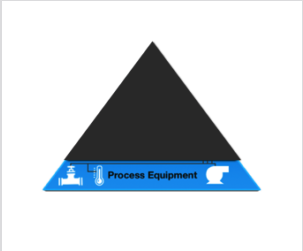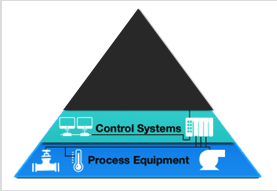Intelligent Automation Series Part 1: Introducing The Intelligent Automation Pyramid
Welcome to the first post in the Intelligent Automation Educational Series; there are a total of six posts that unpack the intelligent automation pyramid.
Technology can be used to fully integrate process and business operations to improve efficiency, reduce operating costs, and increase overall productivity across an entire organization.
This series will explain the automation pyramid-a framework for process intelligence and improvement. The automation pyramid is a roadmap for implementing technology, and is intended to help companies understand process and business operations in greater detail to help them make informed decisions. Part one explains the four layers that encompass the components required to build a world-class system. These levels provide the foundation for implementing the tools and technologies for leveraging the most information-and value-from business processes. The automation pyramid. Courtesy Corso Systems
Layer One: Process equipment
Process equipment is the heart of any operation. Pumps, valves, instrumentation, and associated process equipment make it possible to operate large-scale refineries. A process with only this level of technology is rare because it requires hands-on equipment operation.
Layer Two: Control Systems and PLCs
Due to the inherent safety risks in petroleum processing and the high labor costs involved with manually-operated processes, most refineries consider the second level of the pyramid-control systems-to be the baseline. Control systems include distributed control systems or programmable logic controllers and HMI/SCADA systems that control processes automatically. These systems reduce safety risks and labor costs by allowing operators to run processes from a control room, and increase productivity through the use of automation. Control systems also handle alarms that keep operators apprised of potential process upsets.
Layer Three: Information Systems
Information systems help users get more value out of control systems by extracting intelligence from processes. They provide centralized data collection and storage, spanning across many areas of operation. If a company is considering adding information systems to its process, it typically starts with a process historian, which aggregates process data. A historian provides the ability to track processes over time, comparing different conditions and their influences on every process as well as productivity and quality. Historians allow users to trace process upsets to their sources and monitor them in the future. Beyond a historian, there are several options for expansion that enable correlation between process data, product quality, and maintenance.
Layer Four: Data Analysis
Analyzing data can maximize the value of information systems. Data analysis strategies include systems that can easily understand the health of processes using overall equipment effectiveness and other key performance indicators (KPIs) and reporting tools to share information with all levels of an organization. In the same way information systems add value to the control system, data analysis makes the information systems work even better by automatically generating the information each person needs, regardless of his or her level in the company.
Layer Five: Business System Integration
Business integration provides a bird's-eye view of operations. When coupled with enterprise resource planning systems, this level enables advanced integration into supply chains and scheduling systems. This integration allows information to be shared across an entire organization, giving authorized personnel process and business visibility with information tailored to individual needs.
Putting the Pyramid to Work
Using the automation pyramid framework, businesses can think about intelligent automation and data analysis, putting actionable information to work in a practical way by detailing how each layer builds on the next. Data that become information reduces the amount of work required to get value from systems-moving up the pyramid, from process equipment to business decisions. Starting at the equipment level, run times, speeds, levels, flow rates, temperatures, and many other critical data points are available for control system integration and visualization via the HMI/SCADA system.
Adding information systems reduces the amount of raw data that operators must contend with by providing analysis and trending tools. Reducing the amount of raw data to be analyzed reduces the amount of noise in the data. From there, data can be translated into actionable information for making intelligent business decisions. Data analysis systems can produce actionable information from data by defining KPIs, which reduces complex analysis into parameters that measure critical operations. Other advanced tools, such as statistical process control systems, Pareto analysis, and manufacturing execution systems can provide additional framework to make operational improvements by helping to prioritize the most common issues, and to determine ideal operating conditions for each process.
Integrating business tools into processes turns operational data into timely, accurate, and digestible information about the overall state of business. Business management and development teams can have access to valuable information about performance goals and trends through easy-to-read, real-time dashboards. Decision makers will be empowered to improve efficiency in every aspect of the business. The levels of the automation pyramid work together to lay the foundation for true shop-floor-to-top-floor integration.
Part two: Process and Control
Part three: Process Intelligence Tools
Part four: Data Analysis Systems
Part five: Business System Integration
Part six: Understanding Process Automation Systems
- Alex Marcy wrote this originally for Oil & Gas Engineering, Updated - 6/9/2022



